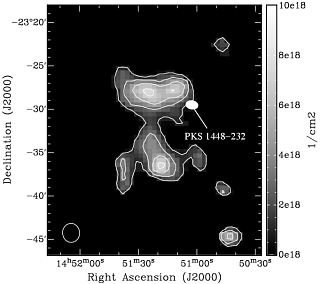Ca Ⅱ and Na Ⅰ absorbers in the Galactic halo

During the past few decades, absorption and emission line measurements have demonstrated that the Milky Way is surrounded by a complex, multi-phase gaseous halo. Embedded in a corona of million-degree gas, neutral and ionised gas clouds move with high radial velocities (|v| > 40 km s−1) through the Galactic halo, giving rise to the population of intermediate- and high-velocity clouds (Wakker 2004). While most of the recent HVC measurements have focused on the distribution and properties of the large IVC and HVC complexes, CHVCs, and highly-ionised HVCs, relatively little attention has been paid so far to the abundance and distribution of neutral gaseous structures in the halo that have H Ⅰ column densities below the detection limit of the large 21-cm HVC surveys (≈ 1019 cm−2).
High-velocity Ca Ⅱ absorbers
Using archival data taken with the UVES spectrograph at the ESO Very Large Telescope (VLT), we detected high-velocity Ca Ⅱ and Na Ⅰ absorption lines towards eight out of 13 quasars, suggesting that the Milky Way halo contains a population of low column density neutral gas clumps. Many of the high-velocity Ca Ⅱ absorbers are presumably associated with known HVCs. For the sightline towards the quasar PKS 1448−232 we carried out additional H Ⅰ observations with the NRAO Very Large Array (VLA). The observations demonstrate that the Ca Ⅱ absorption is associated with low column density H Ⅰ clumps with angular sizes of a few arcmin and peak column densities of ≤ 7 × 1018 cm−2. However, because of the unknown ionisation conditions and the fairly large beam size of the H Ⅰ data of 2 arcmin, we are not able to constrain the metallicity of the gas.

With typical H Ⅰ column densities of less than about 1019 cm−2 and a complex velocity component structure, the properties of the Ca Ⅱ structures in the Milky Way halo resemble those of the strong Mg Ⅱ absorbers that are nearly always found within an impact parameter of about 35 h−1 kpc of luminous galaxies (Ding et al. 2005; Bergeron & Boissé 1991). These strong Mg Ⅱ systems are believed to sample both the disk and halo gas in galaxies. The Ca Ⅱ systems we found possibly represent the Galactic counterparts to the halo Mg Ⅱ systems. Their neutral gas fraction is probably only a few percent or less, hence one would expect that the low column density H Ⅰ clumps in the Galactic halo have substantial, ionised envelopes. It therefore seems likely that the detected Ca Ⅱ features are also related to the population of highly ionised HVCs in the halo seen in C Ⅳ and O Ⅵ absorption (Sembach et al. 2003).
Publications
-
Low column density gas clumps in the halo of the Milky Way
Richter, P., Westmeier, T. & Brüns, C., 2005, A&A, 442, L49
(ADS | arXiv) -
Ca Ⅱ and Na Ⅰ absorption signatures from extraplanar gas in the halo of the Milky Way
Ben Bekhti, N., Richter, P., Westmeier, T. & Murphy, M. T., 2008, A&A, 487, 583
(ADS | arXiv)